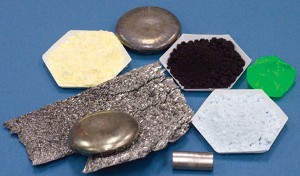The chemical element dysprosium is classed as a lanthanide and rare earth metal. It was discovered in 1886 by Paul Émile Lecoq de Boisbaudran.

Data Zone
| Classification: | Dysprosium is a lanthanide and rare earth metal |
| Color: | silvery-white |
| Atomic weight: | 162.50 |
| State: | solid |
| Melting point: | 1410 oC, 1683 K |
| Boiling point: | 2560 oC , 2833 K |
| Electrons: | 66 |
| Protons: | 66 |
| Neutrons in most abundant isotope: | 98 |
| Electron shells: | 2,8,18,28,8,2 |
| Electron configuration: | [Xe] 4f10 6s2 |
| Density @ 20oC: | 8.536 g/cm3 |
Reactions, Compounds, Radii, Conductivities
| Atomic volume: | 19.0 cm3/mol |
| Structure: | hexagonal close packed |
| Hardness: | – |
| Specific heat capacity | 0.17 J g-1 K-1 |
| Heat of fusion | 11.060 kJ mol-1 |
| Heat of atomization | 291 kJ mol-1 |
| Heat of vaporization | 230.0 kJ mol-1 |
| 1st ionization energy | 571.9 kJ mol-1 |
| 2nd ionization energy | 1126 kJ mol-1 |
| 3rd ionization energy | 2200 kJ mol-1 |
| Electron affinity | – |
| Minimum oxidation number | 0 |
| Min. common oxidation no. | 0 |
| Maximum oxidation number | 3 |
| Max. common oxidation no. | 3 |
| Electronegativity (Pauling Scale) | 1.22 |
| Polarizability volume | 24.5 Å3 |
| Reaction with air | mild, ⇒ Dy2O3 |
| Reaction with 15 M HNO3 | mild, ⇒ Dy(NO3)3 |
| Reaction with 6 M HCl | mild, ⇒ H2, DyCl3 |
| Reaction with 6 M NaOH | – |
| Oxide(s) | Dy2O3 (dysprosia) |
| Hydride(s) | DyH2, DyH3 |
| Chloride(s) | DyCl2, DyCl3 |
| Atomic radius | 175 pm |
| Ionic radius (1+ ion) | – |
| Ionic radius (2+ ion) | 121 pm |
| Ionic radius (3+ ion) | 105.2 pm |
| Ionic radius (1- ion) | – |
| Ionic radius (2- ion) | – |
| Ionic radius (3- ion) | – |
| Thermal conductivity | 10.7 W m-1 K-1 |
| Electrical conductivity | 1.1 x 106 S m-1 |
| Freezing/Melting point: | 1410 oC, 1683 K |
Discovery of Dysprosium
Dysprosium was discovered in 1886 by French chemist Paul Émile Lecoq de Boisbaudran when he separated dysprosium oxide from holmium oxide.
Boisbaudran also discovered gallium in 1875 and isolated samarium for the first time in 1879 using fractional separation.
Boisbaudran developed an intricate and time-consuming procedure for the separation of dysprosium. This involved 32 precipitations of the hydroxide using ammonia followed by 26 precipitations of the insoluble oxalate salt. (1)
Fittingly he named the element dysprosium, from the Greek ‘dysprositos’ meaning ‘hard to obtain.’
Continuing to live up to its name, pure metallic dysprosium was not isolated for about another eighty years: ion-exchange chromatography finally succeeded in the 1950s.
The image below shows a selection of rare earth metals and salts. The left-most metal disc is cast dysprosium, resting on a sheet of sublimated dysprosium. The other metal disc is scandium and the metal cylinder is gadolinium. Image Ref.(2)


Appearance and Characteristics
Harmful effects:
Dysprosium is considered to be moderately toxic.
Characteristics:
Dysprosium is a bright, soft, silvery-white, rare earth metal.
It tarnishes slowly in air at room temperature and dissolves in both dilute and concentrated acids.
When present in compounds, dysprosium exists usually in the trivalent state, Dy3+.
Dysprosium and holmium have the highest magnetic strengths of any elements.
Dysprosium also has a high thermal neutron absorption cross-section. which makes it an excellent neutron absorber.
Uses of Dysprosium
Dysprosium is good at absorbing neutrons and so it is used in dysprosium-oxide-nickel cement in control rods in nuclear reactors.
Terfenol-D (a terbium, iron and dysprosium alloy) expands or contracts in the presence of a magnetic field (magnetostriction) and is used in ships’ sonar systems and in sensors and transducers. Terfenol-D is also used in a speaker called the ‘SoundBug’, which turns any flat surface into a speaker.
Dysprosium is used in data storage applications such as compact discs and hard discs.
It is also used in medium source rare-earth lamps (MSRs) in the film industry. Dysprosium iodide is used these lamps to produce an intense white light.
With vanadium, dysprosium is used in laser materials.
Abundance and Isotopes
Abundance earth’s crust: 6 parts per million by weight, 790 parts per billion by moles
Abundance solar system: 2 parts per billion by weight, 10 parts per trillion by moles
Cost, pure: $450 per 100g
Cost, bulk: $30 per 100g
Source: Dysprosium is not found free in nature but is found in a number of minerals: mainly monazite and bastnaesite. Commercially, it is recovered from monazite sand and bastnaesite using ion exchange and solvent extraction techniques. Dysprosium metal can be produced by reduction of its trifluoride with calcium metal.
Isotopes: Dysprosium has 29 isotopes whose half-lives are known, with mass numbers 141 to 169. Naturally occurring dysprosium is a mixture of seven isotopes and they are found in the percentages shown: 156Dy (0.06%), 158Dy (0.1%), 160Dy (2.3%), 161Dy (18.9%), 162Dy (25.5%), 163Dy (24.9%) and 164Dy (28.2%). The most abundant isotope is 164Dy at 28.2%.

References
- Ferenc Szabadváry, Handbook of the Chemistry and Physics of the Rare Earths Vol. 11., Elsevier Science Publishers., 1998, p56.
- Photo: Ames Laboratory
Cite this Page
For online linking, please copy and paste one of the following:
<a href="https://www.chemicool.com/elements/dysprosium.html">Dysprosium</a>
or
<a href="https://www.chemicool.com/elements/dysprosium.html">Dysprosium Element Facts</a>
To cite this page in an academic document, please use the following MLA compliant citation:
"Dysprosium." Chemicool Periodic Table. Chemicool.com. 05 Oct. 2012. Web. <https://www.chemicool.com/elements/dysprosium.html>.
Hi, this is awesome for my project!!!!!!!!!